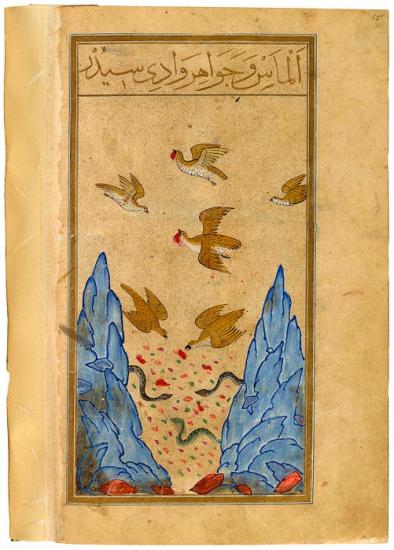
The Valley of Diamonds and Jewels
Maṭāli˓ al-sa˓āda wa manābi˓ al-siyāda (The Ascension of Propitious Stars and Sources of Sovereign), in Turkish
Illuminated by Vali Jan for ˓Āyisha Sulṭān (d.1604), the daughter of Sultan Murād III
Purchased in 1935
In this illustration from a sixteenth-century Turkish manuscript commissioned by Sultan Murād III, the deep rocky valley was filled with diamonds and jewels, and Iskandar (Alexander the Great) was asked how they could be safely obtained, as they were protected by terrible creatures, here represented as poisonous snakes. His solution was to throw raw meat into the valley, to which the gems would stick. The birds would then swoop down into the valley, carry off the gem-laden meat in their talons, and take it to the top, planning to eat the meat there. The birds would then be scared away, and the gems separated from the meat.
Natural History and Astrology
The miniatures presented here derive primarily from two extraordinary Islamic manuscripts that depict the natural world and the heavens. The first, Manāfi˓-i hayavān (The Benefits of Animals), is considered one of the ten greatest surviving Persian manuscripts. It dates from the reign of Ghazan Khan (1295–1304), the Mongol ruler who ordered a Persian translation of the book, and concerns the nature and medicinal properties of humans, animals, birds, reptiles, fish, and insects. The other, Matāli˓ al-sa˓āda wa manābi˓ al-siyāda (The Ascension of Propitious Stars and Sources of Sovereign), was commissioned by Sultan Murād III (r. 1574–95), an Ottoman ruler deeply interested in astronomy, cosmology, demonology, poetry, and mysticism.
